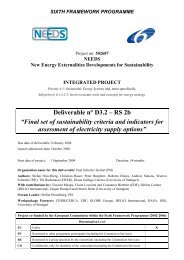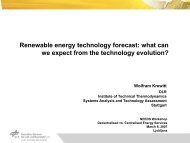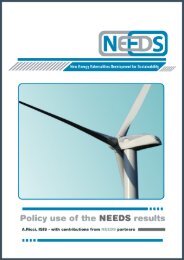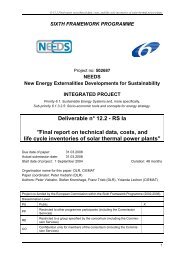Generation, of the energy carrier HYDROGEN In context ... - needs
Generation, of the energy carrier HYDROGEN In context ... - needs
Generation, of the energy carrier HYDROGEN In context ... - needs
You also want an ePaper? Increase the reach of your titles
YUMPU automatically turns print PDFs into web optimized ePapers that Google loves.
NyOrka Page 29 12/18/2008transportation purposes, yet already before 2020 35 its market penetration is set at 5%,whereas China and <strong>In</strong>dia have already started <strong>the</strong>ir experimental use <strong>of</strong> hydrogen and fuelcells.4.3 Cost <strong>of</strong> hydrogen production from two sourcesThe most actual costs for hydrogen technology have been studied with real data derivedfrom H 2 bus demonstrations. Hydrogen vehicle operation in fleets will have spill-overeffects to development <strong>of</strong> o<strong>the</strong>r sectors <strong>of</strong> society. The production stations are,undergoing <strong>the</strong>ir first field demonstrations and <strong>the</strong> figures can only give an indication <strong>of</strong>cost and efficiency, and <strong>the</strong>refore important as first points in a learning curve. Citedreports are deliverables from CUTE, HyFLEET:CUTE bus demonstration projects and<strong>the</strong> Icelandic SMART-H 2 project. This section is presented as on overview <strong>of</strong> <strong>the</strong> currentcost proportions and forecast for <strong>the</strong> production costs, when using real data (figs 13 – 17).Note it is based on <strong>the</strong> technology which is currently in use for hydrogen and is derivedfrom small scale plants that fit transportation demonstrations.The most relevant parameters for <strong>the</strong> interpretation are:• The actual systems used come from differnt manufacturers and have differentboundary conditions such as production capacities. The production unit (PU) <strong>of</strong>all both steam-reformer system and <strong>the</strong> electrolyzer system produce 60 Nm³/h <strong>of</strong>hydrogen. Considering hydrogen losses that occur downstream <strong>of</strong> <strong>the</strong> productionunit, <strong>the</strong> steam-reformer system yields a delivered quantity <strong>of</strong> 43.157 kg H2 /year,while <strong>the</strong> electrolyzer system delivers a quantity <strong>of</strong> 43.465 kg H2 / year.• Of <strong>the</strong>se produced quantities, 43.000 kg H2 /year (each system) are delivered t<strong>of</strong>uel cell buses, while <strong>the</strong> residual amount <strong>of</strong> hydrogen from <strong>the</strong> hydrogen fillingstation is considered as “overproduction” within <strong>the</strong> mass balance <strong>of</strong> <strong>the</strong> system.• <strong>In</strong>itial costs for <strong>the</strong> steam-reformer based system amount to 1,75 Mio. € and to1,74 Mio. € for <strong>the</strong> electrolyzer based system.The total consumption <strong>of</strong> <strong>energy</strong> amounts to 5,7kWh/Nm³ H 2 for both hydrogenproducing systems. <strong>In</strong> <strong>the</strong> case <strong>of</strong> <strong>the</strong> steam-reformer, this includes 4,7 kWh/Nm³ H 2natural gas. The amount 5,7 kWh/Nm³ H 2 also includes <strong>the</strong> <strong>energy</strong> consumption for<strong>the</strong> compression <strong>of</strong> <strong>the</strong> hydrogen up to 350 bar at 15 °C. Electric <strong>energy</strong>, which meets <strong>the</strong>entire <strong>energy</strong> demand <strong>of</strong> <strong>the</strong> electrolyzer based system and 1kWh/Nm³ H2 at <strong>the</strong>steamreformer system is assumed to be purchased for 0,10 €/kWh and natural gas isassumed to be purchased for 0,05 €/kWh. These prices are varied within one similation toshow <strong>the</strong> price elasticity.The cost contributions would be composed within <strong>the</strong> hydrogen supply chain, <strong>the</strong> cost <strong>of</strong>monitoring <strong>the</strong> quality and purification. The presentation is derived with GaBi4 as<strong>of</strong>tware tool for Life Cycle Engineering. LCA costs <strong>of</strong> dismantling and externalities. Thequality criteria were found to be relevant during <strong>the</strong> project CUTE project accounts for<strong>the</strong>se in <strong>the</strong>ir current and future cost estimations 36 .35 Minns David (editor) APEC2030 <strong>In</strong>tegrated Roadmap Nov 2005: Future fuels for <strong>the</strong> APEC region36 Faltenbacher Michael Wittstock TREN/05/FP6EN/ S07.52298/019991







